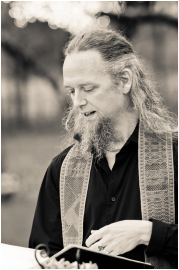
Leonardo da Vinci
I attended a Cadaver Workshop yesterday, what an experience and an honor. I know it's probably not a goal or intention for many of y'all, but it's been something I've really wanted to do, and under the right circumstances, for over two decades now. Fortunately, my training and body-working credentials were enough to get me in, and the experience was incredible.
I'm very grateful and thankful for those individuals and families who support this education through the donation of their bodies. And, to the fine folks at Texas State who stewarded us through the experience. So much respect for what's happening in that space - another holy shala of sorts. Remember, if you don't see the Divine in all, you don't see the Divine at all. So, even in the presence of completely in-animate fellows, folks just like you and me and our families, I appreciate what lessons were given me - mentally, intellectually, emotionally and spiritually.
What else I appreciated was the professionalism of the folks who guided us through the process, including one woman who gave one of the most incredible discussions on the emotional impact of approaching the dead. How we react, how we may react, how to create presence and be with the experience. She spoke so eloquently to the human condition, life, death, the process of dying, how removed from it we are, how confrontational it can be. Powerful lessons on deep spirituality without ever invoking spiritual words or memes. Powerful.
Why a Cadaver Lab? Because honestly, it's the only way to truly appreciate the complete and utter insinuation of the human form; to really grok how your entire body bears the effects of one part, how the entirety contains but is not comprised by the compartments. And, to see and experience the extreme morphology in the form, from person to person. Some hearts were as large as melons, some smaller than fists. One cadaver had only one extremely large lung, and from the appearances, this was not surgical but congenital. Muscle definition, tone, prominence and function clearly varied from body to body.
On a deeper level, metaphorically, I did it for another reason - in order to speak with the dead, but more importantly, to listen to how they speak to me. Our asana practice can be really powerful, but ultimately we're just making shapes and biding our time... how deep do you go? what can 'surrender' really mean to you? It's my conceit and teaching that the asana practice is simply a mimesis of life, and practice for death. It's no mistake or accident that every tradition concludes in Savasana - the pose of the corpse - prior to 'rousing' and 'sealing', the new beginning. I would posit that Savasana is the most important, and yet most under-appreciated and under-utilized pose in the canon.
How and why corpse pose? Because it mimics the trajectory of the life-cycle in the asana practice; we generally begin down on the ground, small, settled and contained, We build vigor, we rise to standing from which we grow into expansion, power, movement, experimentation, success and failure through the peak. The natural trajectory then begins to diminish and we move closer to the earth, into slower and more grounded movements and a more restorative contemplative experience. At the culmination of the practice, we release the body from asana and we release the breathing from the pranayama – release, let go, let dissipate, allow decomposition, letting it die.
Sometimes, it almost appears that we’ve stopped breathing in the depth of savasana, as if we were being breathed from the external, rather from the energy. This is release, union and absorption and dissipation. This is the metaphor for death. To let go in practice so when presented by the actual, we have an association to inform.
And why is Sava the corpse? This corpse - Sava - is interpreted as representing the adept experiencing one of the yoga asanas – Savasana – or ‘posture of the corpse' – in which the yogi lies on his back utterly relaxed in mind and body. All his energies are abandoned and symbolically externalized in the figure of the Shakti dancing above him. In the essence or the implied intention of being that detached from his feminine side - Shakti - the yogi is incomplete and as good as dead.
This belief is expressed in the words: 'shivah shakti vihinah shavah' - 'Shiva deprived of Shakti is Sava (a corpse).' This statement recurs in most of the Tantras in one form or another. So, without the animating grace of the feminine to come into the male corpse, we wouldn’t have the form of Shiva… without the corpse that desires the animation, Shakti would have no lover.
Body without spirit is corpse; spirit without body yearns for expression and union, like lover. So, when we practice for death in the final pose of the practice, we invite the life-force to come and once again reanimate us into the dance of life… dance every day, until Shakti leaves Shiva and Sava is all that remains. Practice, all is coming. Release, for all is going.
“Death must be so beautiful. To lie in the soft brown earth, with the grasses waving above one’s head, and listen to silence. To have no yesterday, and no tomorrow. To forget time, to forgive life, to be at peace.”
Oscar Wilde
Not dead, yet!! And, no large lesson, other than breathe deep, take in Animus Spiritus, and create within the Spritius Sanctus.
Live, and while you are alive, live and give thanks and praise!!



